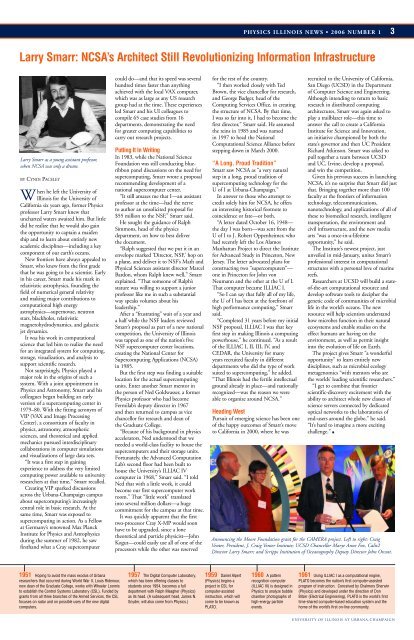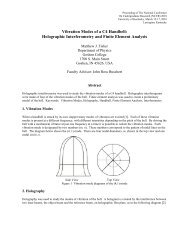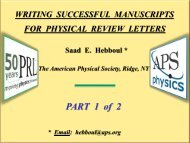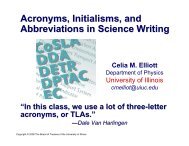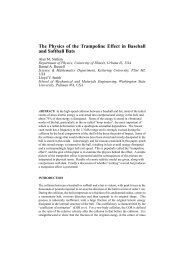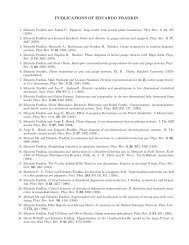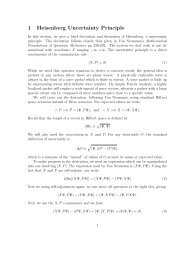Computing - Department of Physics - University of Illinois at Urbana ...
Computing - Department of Physics - University of Illinois at Urbana ...
Computing - Department of Physics - University of Illinois at Urbana ...
You also want an ePaper? Increase the reach of your titles
YUMPU automatically turns print PDFs into web optimized ePapers that Google loves.
PHYSICS ILLINOIS NEWS • 2006 NUMBER 1 3Larry Smarr: NCSA’s Architect Still Revolutionizing Inform<strong>at</strong>ion InfrastructureLarry Smarr as a young assistant pr<strong>of</strong>essor,when NCSA was only a dream.BY CYNDI PACELEYWhen he left the <strong>University</strong> <strong>of</strong><strong>Illinois</strong> for the <strong>University</strong> <strong>of</strong>California six years ago, former <strong>Physics</strong>pr<strong>of</strong>essor Larry Smarr knew th<strong>at</strong>uncharted w<strong>at</strong>ers awaited him. But littledid he realize th<strong>at</strong> he would also gainthe opportunity to captain a maidenship and to learn about entirely newacademic disciplines—including a keycomponent <strong>of</strong> our earth’s oceans.New frontiers have always appealed toSmarr, who knew from the first gradeth<strong>at</strong> he was going to be a scientist. Earlyin his career, Smarr made his mark inrel<strong>at</strong>ivistic astrophysics, founding thefield <strong>of</strong> numerical general rel<strong>at</strong>ivityand making major contributions tocomput<strong>at</strong>ional high energyastrophysics—supernovae, neutronstars, blackholes, rel<strong>at</strong>ivisticmagnetohydrodynamics, and galacticjet dynamics.It was his work in comput<strong>at</strong>ionalscience th<strong>at</strong> led him to realize the needfor an integr<strong>at</strong>ed system for computing,storage, visualiz<strong>at</strong>ion, and analysis tosupport scientific research.Not surprisingly, <strong>Physics</strong> played amajor role in the origins <strong>of</strong> such asystem. With a joint appointment in<strong>Physics</strong> and Astronomy, Smarr and hiscolleagues began building an earlyversion <strong>of</strong> a supercomputing center in1979–80. With the fitting acronym <strong>of</strong>VIP (VAX and Image ProcessingCenter), a consortium <strong>of</strong> faculty inphysics, astronomy, <strong>at</strong>mosphericsciences, and theoretical and appliedmechanics pursued interdisciplinarycollabor<strong>at</strong>ions in computer simul<strong>at</strong>ionsand visualiz<strong>at</strong>ions <strong>of</strong> large d<strong>at</strong>a sets.“It was a first step in gainingexperience to address the very limitedcomputing power available to universityresearchers <strong>at</strong> th<strong>at</strong> time,” Smarr recalled.Cre<strong>at</strong>ing VIP sparked discussionsacross the <strong>Urbana</strong>-Champaign campusabout supercomputing’s increasinglycentral role in basic research. At thesame time, Smarr was exposed tosupercomputing in action. As a Fellow<strong>at</strong> Germany’s renowned Max PlanckInstitute for <strong>Physics</strong> and Astrophysicsduring the summer <strong>of</strong> 1982, he sawfirsthand wh<strong>at</strong> a Cray supercomputercould do—and th<strong>at</strong> its speed was severalhundred times faster than anythingachieved with the local VAX computer,which was as large as any US researchgroup had <strong>at</strong> the time. These experiencesled Smarr and his UI colleagues tocompile 65 case studies from 16departments, demonstr<strong>at</strong>ing the needfor gre<strong>at</strong>er computing capabilities tocarry out research projects.Putting It In WritingIn 1983, while the N<strong>at</strong>ional ScienceFound<strong>at</strong>ion was still conducting blueribbonpanel discussions on the need forsupercomputing, Smarr wrote a proposalrecommending development <strong>of</strong> an<strong>at</strong>ional supercomputer center.“It still amazes me th<strong>at</strong> I—an assistantpr<strong>of</strong>essor <strong>at</strong> the time—had the nerveto author an unsolicited proposal for$55 million to the NSF,” Smarr said.He sought the guidance <strong>of</strong> RalphSimmons, head <strong>of</strong> the physicsdepartment, on how to best deliverthe document.“Ralph suggested th<strong>at</strong> we put it in anenvelope marked ‘Director, NSF,’ hop ona plane, and deliver it to NSF’s M<strong>at</strong>h andPhysical Sciences assistant director MarcelBardon, whom Ralph knew well,” Smarrexplained. “Th<strong>at</strong> someone <strong>of</strong> Ralph’sst<strong>at</strong>ure was willing to support a juniorpr<strong>of</strong>essor like me in such a substantialway speaks volumes about hisleadership.”After a “frustr<strong>at</strong>ing” wait <strong>of</strong> a year anda half while the NSF leaders reviewedSmarr’s proposal as part <strong>of</strong> a new n<strong>at</strong>ionalcompetition, the <strong>University</strong> <strong>of</strong> <strong>Illinois</strong>was tapped as one <strong>of</strong> the n<strong>at</strong>ion’s fiveNSF supercomputer center loc<strong>at</strong>ions,cre<strong>at</strong>ing the N<strong>at</strong>ional Center forSupercomputing Applic<strong>at</strong>ions (NCSA)in 1985.But the first step was finding a suitableloc<strong>at</strong>ion for the actual supercomputingunits. Enter another Smarr mentor inthe person <strong>of</strong> Ned Goldwasser, a former<strong>Physics</strong> pr<strong>of</strong>essor who had becomeFermilab’s deputy director in 1967and then returned to campus as vicechancellor for research and dean <strong>of</strong>the Gradu<strong>at</strong>e College.“Because <strong>of</strong> his background in physicsacceler<strong>at</strong>ors, Ned understood th<strong>at</strong> weneeded a world-class facility to house thesupercomputers and their storage units.Fortun<strong>at</strong>ely, the Advanced Comput<strong>at</strong>ionLab’s second floor had been built tohouse the <strong>University</strong>’s ILLIAC IVcomputer in 1968,” Smarr said. “I toldNed th<strong>at</strong> with a little work, it couldbecome our first supercomputer workroom.” Th<strong>at</strong> “little work” transl<strong>at</strong>edinto several million dollars—a hugecommitment for the campus <strong>at</strong> th<strong>at</strong> time.It was quickly apparent th<strong>at</strong> the firsttwo-processor Cray X-MP would soonhave to be upgraded, since a lonetheoretical and particle physicist—JohnKogut—could easily use all <strong>of</strong> one <strong>of</strong> theprocessors while the other was reservedfor the rest <strong>of</strong> the country.“I then worked closely with TedBrown, the vice chancellor for research,and George Badger, head <strong>of</strong> the<strong>Computing</strong> Services Office, in cre<strong>at</strong>ingthe structure <strong>of</strong> NCSA. By th<strong>at</strong> time,I was so far into it, I had to become thefirst director,” Smarr said. He assumedthe reins in 1985 and was namedin 1997 to head the N<strong>at</strong>ionalComput<strong>at</strong>ional Science Alliance beforestepping down in March 2000.“A Long, Proud Tradition”Smarr saw NCSA as “a very n<strong>at</strong>uralstep in a long, proud tradition <strong>of</strong>supercomputing technology for theU <strong>of</strong> I <strong>at</strong> <strong>Urbana</strong>-Champaign.”In answer to those who <strong>at</strong>tempt tocredit solely him for NCSA, he <strong>of</strong>fersan interesting historical footnote tocoincidence or f<strong>at</strong>e—or both.“A letter d<strong>at</strong>ed October 16, 1948—the day I was born—was sent from theU <strong>of</strong> I to J. Robert Oppenheimer, whohad recently left the Los AlamosManh<strong>at</strong>tan Project to direct the Institutefor Advanced Study in Princeton, NewJersey. The letter advoc<strong>at</strong>ed plans forconstructing two “supercomputers”—one in Princeton for John vonNeumann and the other <strong>at</strong> the U <strong>of</strong> I.Th<strong>at</strong> computer became ILLIAC I.“So I can say th<strong>at</strong> fully all <strong>of</strong> my life,the U <strong>of</strong> I has been <strong>at</strong> the forefront <strong>of</strong>high performance computing,” Smarrsaid.“Completed 31 years before my initialNSF proposal, ILLIAC I was th<strong>at</strong> keyfirst step in making <strong>Illinois</strong> a computingpowerhouse,” he continued. “As a result<strong>of</strong> the ILLIAC I, II, III, IV, andCEDAR, the <strong>University</strong> for manyyears recruited faculty in differentdepartments who did the type <strong>of</strong> worksuited to supercomputing,” he added.“Th<strong>at</strong> <strong>Illinois</strong> had the fertile intellectualground already in place—and n<strong>at</strong>ionallyrecognized—was the reason we wereable to organize around NCSA.”Heading WestPursuit <strong>of</strong> emerging science has been one<strong>of</strong> the happy outcomes <strong>of</strong> Smarr’s moveto California in 2000, where he wasrecruited to the <strong>University</strong> <strong>of</strong> California,San Diego (UCSD) in the <strong>Department</strong><strong>of</strong> Computer Science and Engineering.Although intending to return to basicresearch in distributed computingarchitectures, Smarr was again asked toplay a trailblazer role—this time toanswer the call to cre<strong>at</strong>e a CaliforniaInstitute for Science and Innov<strong>at</strong>ion,an initi<strong>at</strong>ive championed by both thest<strong>at</strong>e’s governor and then UC PresidentRichard Atkinson. Smarr was asked topull together a team between UCSDand UC, Irvine, develop a proposal,and win the competition.Given his previous success in launchingNCSA, it’s no surprise th<strong>at</strong> Smarr did justth<strong>at</strong>. Bringing together more than 100faculty <strong>at</strong> the frontiers <strong>of</strong> inform<strong>at</strong>iontechnology, telecommunic<strong>at</strong>ions,nanotechnology, and applic<strong>at</strong>ions <strong>of</strong> all <strong>of</strong>these to biomedical research, intelligenttransport<strong>at</strong>ion, the environment andcivil infrastructure, and the new mediaarts “was a once-in-a-lifetimeopportunity,” he said.The Institute’s newest project, justunveiled in mid-January, unites Smarr’spr<strong>of</strong>essional interest in comput<strong>at</strong>ionalstructures with a personal love <strong>of</strong> marinereefs.Researchers <strong>at</strong> UCSD will build a st<strong>at</strong>e<strong>of</strong>-the-artcomput<strong>at</strong>ional resource anddevelop s<strong>of</strong>tware tools to decipher thegenetic code <strong>of</strong> communities <strong>of</strong> microbiallife in the world’s oceans. The newresource will help scientists understandhow microbes function in their n<strong>at</strong>uralecosystems and enable studies on theeffect humans are having on theenvironment, as well as permit insightinto the evolution <strong>of</strong> life on Earth.The project gives Smarr “a wonderfulopportunity” to learn entirely newdisciplines, such as microbial ecologymetagenomics “with mentors who arethe worlds’ leading scientific researchers.”“I get to combine th<strong>at</strong> frontierscientific-discovery excitement with theability to architect whole new classes <strong>of</strong>science servers connected by dedic<strong>at</strong>edoptical networks to the labor<strong>at</strong>ories <strong>of</strong>end-users around the globe,” he said.“It’s hard to imagine a more excitingchallenge.” ■Announcing the Moore Found<strong>at</strong>ion grant for the CAMERA project. Left to right: CraigVenter, President, J. Craig Venter Institute; UCSD Chancellor Marye Anne Fox, Calit2Director Larry Smarr; and Scripps Institution <strong>of</strong> Oceanography Deputy Director John Orcutt.1951 Hoping to avoid the mass exodus <strong>of</strong> <strong>Urbana</strong>researchers th<strong>at</strong> occurred during World War II, Louis Ridenour,now dean <strong>of</strong> the Gradu<strong>at</strong>e College, works with Wheeler Loomisto establish the Control Systems Labor<strong>at</strong>ory (CSL). Funded bygrants from all three branches <strong>of</strong> the Armed Services, the CSLfocuses on radar and on possible uses <strong>of</strong> the new digitalcomputers.1957 The Digital Computer Labor<strong>at</strong>ory,which has been <strong>of</strong>fering classes tostudents since 1954, becomes a fulldepartment with Ralph Meagher (<strong>Physics</strong>)as its head. (A subsequent head, James N.Snyder, will also come from <strong>Physics</strong>.)1959 Daniel Alpert(<strong>Physics</strong>) begins aproject in CSL forcomputer-assistedinstruction, which willcome to be known asPLATO.1960 A p<strong>at</strong>ternrecognition computer(ILLIAC III) is designed in<strong>Physics</strong> to analyze bubblechamber photographs <strong>of</strong>high-energy particleevents.1961 Using ILLIAC I as a comput<strong>at</strong>ional engine,PLATO becomes the n<strong>at</strong>ion’s first computer-assistedprogram <strong>of</strong> instruction. Conceived by Chalmers Sherwin(<strong>Physics</strong>) and developed under the direction <strong>of</strong> DonBitzer (Electrical Engineering), PLATO is the world’s firsttime-shared computer-based educ<strong>at</strong>ion system and thehome <strong>of</strong> the world’s first on-line community.UNIVERSITY OF ILLINOIS AT URBANA-CHAMPAIGN


